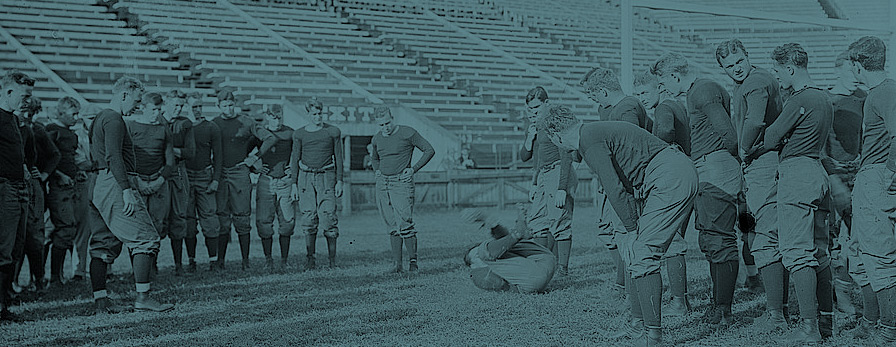We researched 10 years (2001-2010) and 12,000+ NCAA D-I football players’ recruiting class ranking 1 to explore relationships between 3+ star recruits and all other recruits for two things: success on the field (wins) and success in developing talent (NFL draft picks) 2
To do that, we focused first on 3-star, 4-star, and 5-star recruits as they were ranked coming out of high school and followed those players during their college careers. We then tallied the number of those starred recruits that a school had at their disposal any given year. So during the 2006 season, teams would have had the services of their recruits from the five years between 2002 and 2006, including a redshirt year. Even though some players leave school early, transfer, or never even see the playing field for a particular reason, we’re not focused on that or anything that might happen due to chance – again, we’re focused on what schools are able to do once those players are recruited.Our research addresses the following questions.
- What is the level of attendance boost that star recruits bring to the stands
- Does the strength of a recruiting class contribute to winning?
- Which programs produce the most NFL draft picks, relative to the amount of high school ranked stars? Are some programs good recruiters and teachers?
- Among the programs that recruit the most highly rated high school players, which coaches are the most productive in shaping that talent into NFL draft picks? Which coaches were the best at helping non-star players get drafted?
Question 1: What is the level of attendance boost that star recruits bring to the stands?
It is well known that fans pay to see great players. In fact, we found a .886 correlation between a team’s home average attendance and the number of stars on that team. Appendix I plots the data visually. Translating that strong relationship into ticket sales, for every extra 3-star recruit on a team, attendance will increase by 530 fans. For every 4-star recruit on a team, attendance will increase by 710 fans. For every 5-star recruit on a team, attendance will increase by 885 fans. Digging a bit further, we found that the position of star recruits, whether they are skill players (QB, RB, WR) or in the trenches (OL, DL, DB), does not have a significant impact on attendance. Instead, more star players, at any position, means better attendance.
These figures are based on the correlation between a team’s home average attendance and the number of stars on the roster (i.e., a 2006 team would have the recruits from 2002-2006 available). We think the practical application of this finding could be very straightforward. Since attendance is correlated with star players, it makes sense for programs to market those star players to optimize ticket sales. If a program wants to boost attendance, the marketing department should prominently feature star players in advertisements that are intended to drive ticket sales. (The obvious corollary: if a school wants to attract higher caliber, starred players, a proven way to do that is to boost attendance). The summertime planning for football marketing activities should consider this finding.
Question 2: Does the strength of a recruiting class contribute to winning on the field?
To analyze this question, we focused on the last five seasons, 2006-2010, giving us nearly 600 teams and over 11,000 players to analyze. Looking at that group as a whole, we found there’s no direct relationship between the amount of 3+star players on a team and overall winning percentage. 3
There is more of a correlation between the smaller sub-set of starred skill players (QB, RB, WR, & ATH) and winning percentage, but no unique combination among those skill positions that maximizes their strengths. However, when we review the same data but control for strength of schedule and strength of conference by comparing teams within each conference, we found that more star players on a team usually means that team will perform better in the conference than teams in the same conference with less star players. Specifically, 25 times out of 55 (or 45% of the time), the team with the most starred players in the conference ended up with the best or second-best conference winning percentage. Likewise, the team with the least amount of starred players in the conference finished in the bottom half of conference winning percentage 33 times out of 55 (60% of the time). Some conferences showed more of a tendency for the amount of star players to predict the conference rankings (the SEC and WAC), but not consistently and not all that significantly. At the same time, the positions of the star players did not show any results in our analysis, positive or negative, with regard to conference winning percentage or standing.
This led us to ask, who are the successful coaches (teams with 11+ wins over the last five years) without as much star talent (measured as highly rated high school recruits)? Here’s what we found.
TABLE 1: Coaches Who Get Great Results from Good (Not “Great”) Talent
 These are standout coaches. They get the most out of their recruiting classes on the field. We think these coaches are great teachers of the college game, since they are achieving excellent results with talent that is not top ranked.
These are standout coaches. They get the most out of their recruiting classes on the field. We think these coaches are great teachers of the college game, since they are achieving excellent results with talent that is not top ranked.
Question 3: Which programs produce the most NFL draft picks, relative to the amount of high school ranked stars? Are some programs significantly better recruiters and teachers?
To answer this question, we explored which schools are able to keep their star recruits playing at a peak level, preparing them for a career in the NFL. By multiplying the number of star recruits drafted by the percentage of those recruits drafted, the results in Table 2 provide a good, relative indication of how successful schools are in this regard.
TABLE 2: NFL Draft Picks, Ranked by College Program – Star Recruits
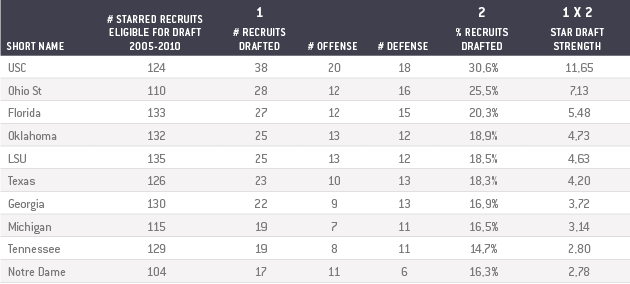 Not surprisingly, the programs in Table 2 represent large revenue schools. These programs have natural advantages to attract highly ranked high school players. Because these programs draw more of those highly ranked high school players, it is logical that they produce more NFL draft picks. These programs clearly recruit well and produce a high percentage of NFL players.
Not surprisingly, the programs in Table 2 represent large revenue schools. These programs have natural advantages to attract highly ranked high school players. Because these programs draw more of those highly ranked high school players, it is logical that they produce more NFL draft picks. These programs clearly recruit well and produce a high percentage of NFL players.
This begs the natural follow up question: which programs are best at developing their non-star players and getting them drafted? Table 3 reflects our findings to that question.
TABLE 3: NFL Draft Picks, Ranked by College Program – Non-Star Recruits
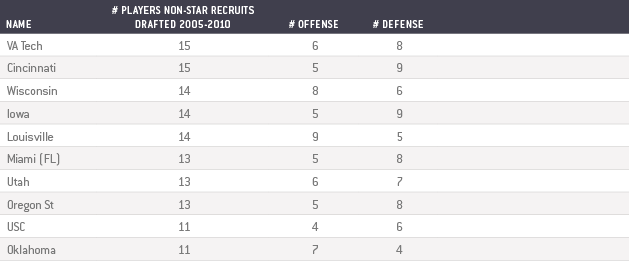 These programs (in Table 3) are fantastic at developing players in the college game for being attractive talent (measured as draft picks) in the NFL. These programs in Table 2 and Table 3 tell us which programs produced the most NFL talent from star and non-star high school recruits between 2006 and 2010. Looking across the names of the programs in Tables 2 and 3, USC and Oklahoma are the two programs whose coaches appear to excel in both domains. In Appendix II, we provide a ranking of all schools overall recruiting-drafting strength.
These programs (in Table 3) are fantastic at developing players in the college game for being attractive talent (measured as draft picks) in the NFL. These programs in Table 2 and Table 3 tell us which programs produced the most NFL talent from star and non-star high school recruits between 2006 and 2010. Looking across the names of the programs in Tables 2 and 3, USC and Oklahoma are the two programs whose coaches appear to excel in both domains. In Appendix II, we provide a ranking of all schools overall recruiting-drafting strength.
Question 4: Among the programs that recruit the most highly rated high school players, which coaches are the most productive in shaping that talent into NFL draft picks? Which coaches were the best at helping non-star players get drafted?
First, among the programs that recruit the most highly rated high school players, which coaches are the most productive in shaping that talent into NFL draft picks? Looking at players drafted between 2006 and 2010,Table 4 shows the coaches who spent the most time with their star pupils who became NFL draft picks. 4
TABLE 4: NFL Draft Picks, Ranked by Collegiate Coach – Star Recruits
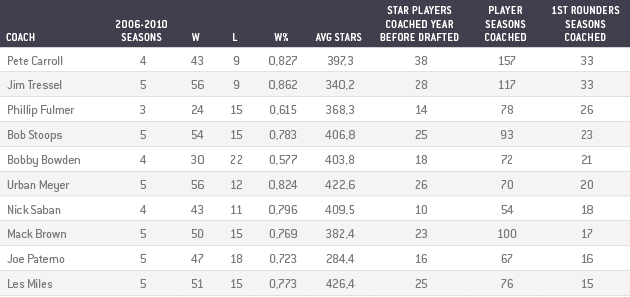 Along those same lines, which coaches were the best at helping non-star players get drafted? Table 5 contains our findings.
Along those same lines, which coaches were the best at helping non-star players get drafted? Table 5 contains our findings.
TABLE 5: NFL Draft Picks, Ranked by Collegiate Coach – Non-Star Recruits
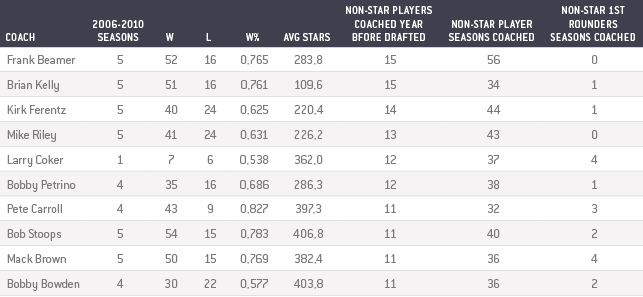 The reason we examine player seasons with the coaches and not the programs is because it illuminates which coaches stand out regardless of what program they are/were associated with. Most of the coaches on this list were long-tenured at their schools, allowing them to both recruit and develop their players. But some, like Brian Kelly, were at multiple schools. This means that they were able to effectively develop the players they were dealt in the few seasons they had with them. So overall, while an elite program is typically a well-oiled machine in turning out draft prospects, having the right coach in place can make a huge difference as well.
The reason we examine player seasons with the coaches and not the programs is because it illuminates which coaches stand out regardless of what program they are/were associated with. Most of the coaches on this list were long-tenured at their schools, allowing them to both recruit and develop their players. But some, like Brian Kelly, were at multiple schools. This means that they were able to effectively develop the players they were dealt in the few seasons they had with them. So overall, while an elite program is typically a well-oiled machine in turning out draft prospects, having the right coach in place can make a huge difference as well.
References:
- We used recruiting class ranking data from Rivals.com ↩
- The February 2008 issue of The Journal of Sports Economics featured an econometric model developed by three Ph.D. economists (Mike DuMond, Allen Lynch and Jennifer Platania) to predict the collegiate choices of high school football players. Their work was featured in Andy Staples’ January 21, 2009 piece in Sports Illustrated (“The State of Recruiting”), which noted “programs which draw at least 50 percent of their players from within 200 miles or from within their home state stand a far better chance of winning consistently than those that did not.” That research and reporting coupled with stories on February 1, 2010 by Tim Booth of AP Sports (“Broncos buck trend of low-rated recruiting classes”) and Jack Carey at USA Today (“Wisconsin consistently outperforms recruiting rank”) piqued our interest. ↩
In fact, there’s no significant positive correlation between the amount of starred players and any other statistical category, except attendance as discussed above. We checked more than 100+ performance statistics, including points, yards and touchdowns. We found no significant relationship between higher ranked recruiting classes and better performance statistics. As an aside, we initially believed there would be the opportunity to highlight certain coaches whose teams outperform others, relative to strength of recruiting class (e.g., a coach with a 50th ranked recruiting class outperforms – via wins – coaches with higher ranked recruiting classes). However, the data did not indicate any such relationship. That was a surprising non-finding for us. ↩- Two comments (not findings) about part of what may be underpinning the data presented in Table 4. First, it could be that average players become better by playing with star players, irrespective of coaching. While coaches / programs attract the best talent, it could be that the presence of star players in a team elevates the performance of all the athletes. Second, it is possible that NFL teams are conservative in the draft room, indicating selection bias by drafting from elite teams as “safer bets” even though players from other programs have been just as successful measured by winning percentage in college games. ↩

